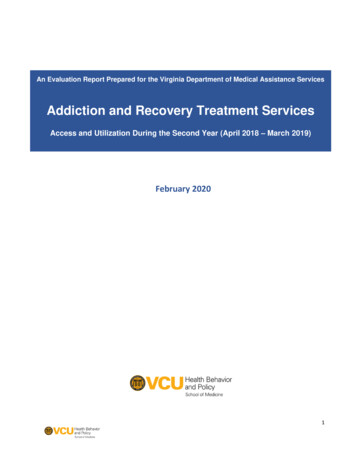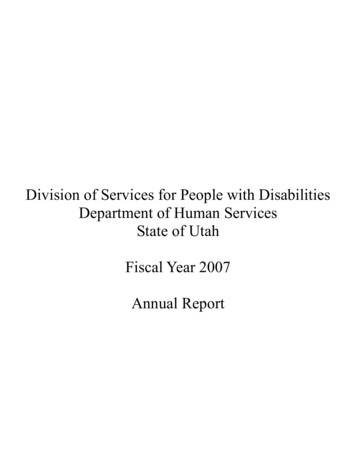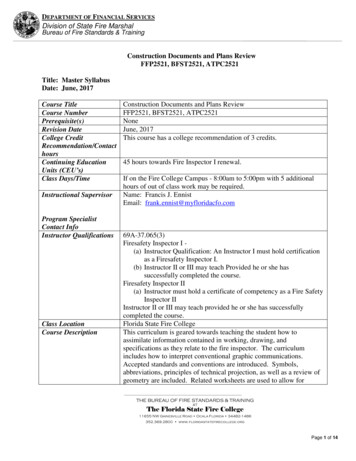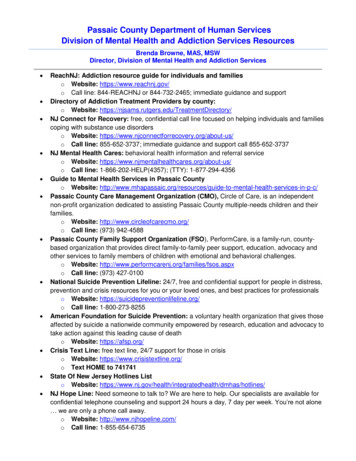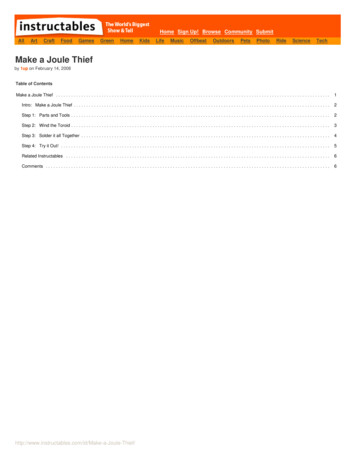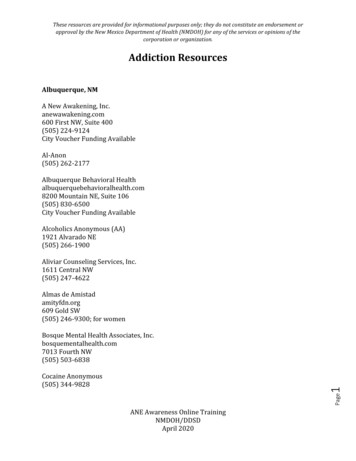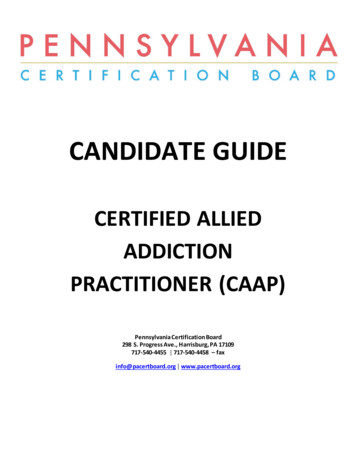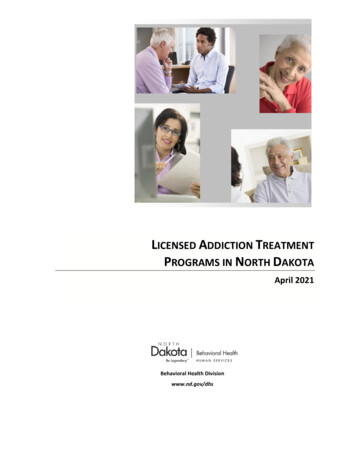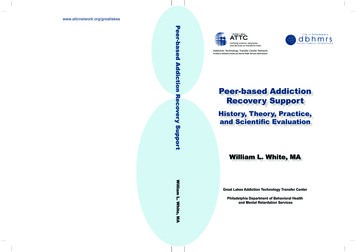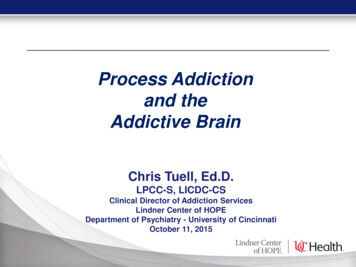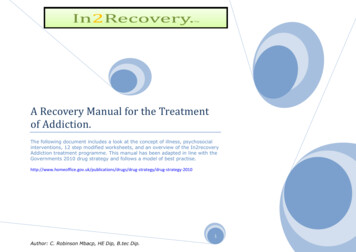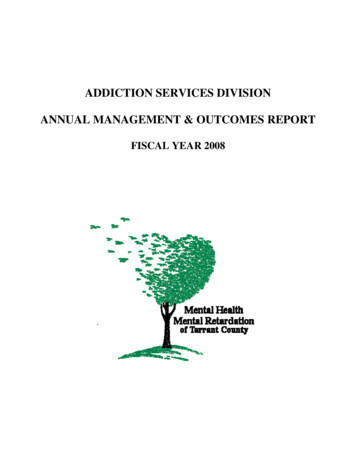
Transcription
ADDICTION SERVICES DIVISIONANNUAL MANAGEMENT & OUTCOMES REPORTFISCAL YEAR 2008
Prepared by David Helton MSSW-LMSW, LCDCDivision Directorwith significant contributions from Division Management Team membersFor questions or comments contact:Stevie Hansen, Chief of Addiction Services Division (817) 569-4452David Helton, Division Director – Addiction Services (817) 569-4449
Table of Contents(Click on page # to go to that page)PageOverview .1 Outcome Evaluation System .2 Services Provided 3Client Demographics and Program Outcomes .4 Adult Client Demographics 5 Adolescent Client Demographics .6 Performance Measures . .6 Other Effectiveness and Efficiency Measures 8 Specialized Populations .15 Services for Those With or At Risk for HIV/AIDS .16 Services for Homeless Drug Users .26 Services for Adolescent Substance Abusers . .29Fiscal & Efficiency Outcome Data. 33Referral Source Satisfaction and Needs Assessment .37Staff Satisfaction Survey .44Client Satisfaction Surveys .48Attachments .71MHMRTC AdSFY08 Mgmt Repi
Tables(Click on Table # or Page # to go to table)PageTable 1: Adult Program Clients Served FY 07 vs FY 08 5Table 2: Youth Program Clients Served FY 07 vs FY 08 . .6Table 3: Adult Performance Measures and Target Goals for Residential and Detox Programs FY08. .7Table 4: Adult Performance Measures and Target Goals for Outpatient Programs FY08 . 7Table 5: Adolescent Performance Measures and Target Goals for Residential and Outpatient Programs FY08 . .8Table 6: Client outcome variables for Adult Intensive Residential program after 60 days following discharge FY08. 9Table 7: Client outcome variables for Adult Outpatient program after 60 days following discharge FY08. .10Table 8: TYRC Youth Characteristics at Discharge FY08. .11Table 9: TYRC Youth Client Characteristics at 60 Day Follow Up FY08. . . .12Table 10: HIV Street Outreach FY08 . .19Table 11: Project Health First FY08. 21Table 12: Ryan White FY08 .23Table 13: Project HOPE Treatment Completion Rates FY08 29Table 14: Fiscal Comparison Data for Adult Addiction Services Programs from FY 04 thru FY 08. . .34Table 15: Fiscal Comparison Data for Adolescent Addiction Services Programs from FY05 thru FY08 . .35Table 16: Referral Source Satisfaction Survey Average Scores for Scaled Questions FY08 38Table 17: Referral Source Satisfaction Survey Scaled Questions Actual Responses by Agency FY08 39Table 18: Referral Source Satisfaction Survey Open-Ended Questions Responses by Agency FY08. .41Table 19: Staff Satisfaction Average Scores By Program FY08 44Tables 20-27: Client Satisfaction Survey Responses by Program FY08. .63MHMRTC AdSFY08 Mgmt Repii
OverviewMHMRTC AdSFY08 Mgmt Rep1
OVERVIEWMHMRTC- Addiction Services (AdS) is a division of Mental Health Mental Retardation Servicesof Tarrant County (MHMRTC).MHMRTC has been in operation for over 30 years assisting TarrantCounty residents overcome the problems associated with mental illness, mental retardation, addictivebehaviors, and early childhood developmental delays.MHMRTC employs over 1100 employees atseveral sites within Tarrant County, and has an operating budget of approximately 70 million dollars.The Addiction Services Division (AdS) is Tarrant County’s largest, non-profit, chemicaldependency treatment provider for the medically indigent.Annually, the AdS Division providessubstance abuse intervention and treatment to 4,000-5,000 individuals, as well as education, casemanagement, dual diagnosis and HIV/substance abuse groups, and street outreach services to 15,00020,000 individuals in Tarrant and Denton counties. AdS offers a full continuum of care, ranging fromaddiction education to detoxification services. Services are also offered to various specialized populationssuch as adolescents, dually diagnosed clients, the homeless and clients who are living with both addictionand HIV/AIDS.The purpose of this report is to summarize the operations of the Addiction Services Division forfiscal year 2008, which began September 1, 2007 and ended August 31, 2008. When possible, data fromthe previous year will be utilized as a means of comparison and analysis of trends. This summary of AdSoperations will include outcome evaluation data, client demographic characteristics, and performancemeasures on selected criteria, evaluation of efficiency and referral source satisfaction, and clientsatisfaction data.The information provided in this report is reviewed by Addiction Services staff and the DivisionManagement Team, and made available to the Board of Trustees, other agency divisions, consumers, andcommunity agencies. The summarization and findings are utilized to assist in the planning for futureoperations and to make substantial programmatic and operational changes to improve the overall quality,efficiency and effectiveness of the Division.OUTCOME EVALUATION SYSTEMMHMRTC Addiction Services Division (AdS) utilizes a comprehensive system for programevaluation and client outcomes. This data management system ensures compliance with funding sourcesby obtaining continuous information on the effectiveness of services and satisfaction of consumers served.Admission, discharge, and follow-up forms are completed for all clients served by AdS. TheTexas Department of State Health Services (DSHS, the primary funding source for AdS programs)requires these data collection instruments/forms for all clients served using DSHS funds. These samedata collection instruments are used with all clients served by the AdS division, however, in order toprovide consistent and standardized information across client populations.MHMRTC AdSFY08 Mgmt Rep2
The Admission Report contains client information at intake such as demographic, substanceabuse, and other information related to behaviors and impairment in areas of social functioning,family/marital problems, psychological/emotional issues and physical health symptoms. The Dischargeand Follow-up reports contain information at discharge from treatment and at 60 days following dischargefrom services such as satisfaction with services, substance abuse behaviors, recovery activities, andimprovement in quality of life (in areas such as family/social functioning, physical symptoms,employment, or psychological functioning). Data from these required forms is evaluated for changes inclient status/behavior from intake to follow-up after discharge.AdS also have outcome measurements that specifically address consumer satisfaction, staffsatisfaction, and referral source satisfaction. Clients are encouraged to complete satisfaction surveysduring treatment and/or upon discharge. Additionally, satisfaction surveys are distributed annually toreferral source/ external providers to assess their experience with the Addiction Services Division and theeffectiveness and efficiency of our services.All outcome measures, forms and surveys are analyzed by an AdS Division Director whocompiles the outcome data and then reports the findings to the Division Management Team. All clientdemographics and program outcomes are then summarized in the Addiction Services AnnualManagement and Outcomes Report.SERVICES PROVIDEDThe Addiction Services Division provided a wide variety of substance abuse treatment services inFY 08 including inpatient treatment at The Recovery Center (Billy Gregory detoxification and Pine Streetintensive residential) and at the Tarrant Youth Recovery Campus (TYRC), and outpatient treatment at twoadult service sites (Community Addiction Treatment Services-C.A.T.S. and the Addiction RecoveryCenter-Harmon Road), including ambulatory detox, and several adolescent service sites. In addition,Addiction Services provided several specialized service programs such as the HIV Early InterventionProgram, HIV/ Substance Abuse Street Outreach Program, Project Health First Plus (PHFP), Ryan WhiteI funded programming, the Rural Street Outreach (RSOR) program, the Assertive Adolescent FamilyTreatment (AAFT) program, and the HUD-funded Supporting the Homeless program. These specializedprograms have different evaluation criteria from the general adult and adolescent substance abusetreatment programs and will be discussed individually within this report.MHMRTC AdSFY08 Mgmt Rep3
ClientDemographics& ProgramOutcomesMHMRTC AdSFY08 Mgmt Rep4
CLIENT DEMOGRAPHICS AND PROGRAM OUTCOMESCLIENT DEMOGRAPHICSPrimarily from data obtained through reports generated by the Department of State HealthServices (DSHS) and through data entered into DSHS’s Behavioral Health Integrated Provider System(BHIPS), as well as our own internal agency database, programmatic information was compiled andexamined in terms of client demographics and program/client outcomes for the adult and adolescentsubstance abuse treatment programs. For the purposes of this report, some information is combined torepresent inpatient and outpatient programs; and in other cases the data will represent the individualprograms, including detoxification (adult only), intensive residential, and outpatient.Table 1: Program (inpatient and outpatient) demographics based on Adult admissions during FY 07 andFY 08.Adult Program DemographicsInpatientMeasureOutpatientTotal Admitted*DetoxificationResidential% No Prior Treatment% Married% Female% Curr Using Needles% African-American% Hispanic% Employed% Criminal Justice% Homeless% Alcohol primary% Cocaine primary% Opiates primary% Marijuana primaryFY 34.015.037.02.0FY 13.326.22.0FY 0823042029 (IOP/SOP)275 (amb 9.9**15.8FY 0722081977 (IOP/SOP)231 (amb 8.514.5% Meth/amphetamines primary9.113.120.129.6% Polysubstance Use72.066.556.252.8Total Days or ation Days4,9934,2202,292 amb detox1,724 amb detoxResidential Days18,48218,307Group Hours48,48344,763Individual Hours5,1455,060* From BHIPS Admissions all of FY07 and FY08 off Client Characteristics report.** Clients served in ambulatory detox have begun to shift from cocaine/methamphetamine to heroin/opiate users due to newSuboxone (Buprenorphine) medication. Note also that the primary drugs of abuse in residential detox are opiates (55%) andalcohol (41%); and in intensive residential the primary drugs are cocaine/crack (30%), alcohol (27%) and opiates (19%).*** Approx 25% of intensive residential clients are homelessMHMRTC AdSFY08 Mgmt Rep5
On September 1, 2001 (FY2002), MHMRTC- AdS began providing all levels of treatment care at theTarrant Youth Recovery Campus, including 16 intensive residential beds for adolescent boys andsupportive and intensive outpatient for both adolescent boys and girls. Table 2 illustrates the number ofclients served in each level of care for FY07 vs. FY08, as well as specific characteristics of those admittedinto treatment.Table 2: Program (inpatient and outpatient) demographics based on Youth admissions during FY 07 andFY 08.MeasureYouth Program DemographicsResidentialFY08FY07FY08Total .1011355448732749905230205933565386660 1181156128574681851250534241Of Youth Admitted:% No Prior Treatment% With Substance AbusingParent% Female% Curr Using Needles% African-American% Hispanic% Gang History% Criminal Justice% Failing Grades% Marijuana Primary Problem% Alcohol Primary Problem% Cocaine Primary Problem% Inhalants Primary Problem% Methamphetamine PrimaryProblem% Polysubstance UseTotal Days or HoursResidential Days5,8255,8255,7185,718OP Group HoursOP Individual HoursOutpatientFY 0711,12310,4438,4812,6428,5431,900PERFORMANCE MEASURESTreatment performance measures and outcome measures are the data utilized by DSHS to review andevaluate the AdS programs. The DSHS evaluation criterion is as follows:1)Percent of clients completing treatment (successfully completed at least an average of 75% of theplanned treatment duration and treatment objectives), by program and level of service.2)Percent of clients contacted by AdS staff at 60 day follow-up, by program and level of service.3)Percent of clients maintaining abstinence at follow-up (no alcohol or drug use for the previous 30days), by program and level of service.4)Percent of completed clients given a referral for continued treatment services at discharge (detoxprogram only).MHMRTC AdSFY08 Mgmt Rep6
Tables 3 and 4 detail the performance measures for the AdS general adult inpatient and outpatientprograms, the established target goal, and the actual DSHS goal achieved for both fiscal years 2007 and2008.Table 3: Performance measures and target goals for Adult inpatient programs: Residential Detox Billy GregoryDetox, Intensive Residential Pine Street for FY07 vs. FY08ADULT INPATIENTPERFORMANCEMEASUREResidential Detox **Intensive ResidentialTARGETFY 08FY 07TARGETFY 08FY 07Completion Rate70%89%80%70%80%81%Abstinence Rate50%62%63%70%75%75%Follow Up eferral Rate(detox only)**Although DSHS does not have a performance measure requirement for residential detox completion, abstinence rate or followup contactrate, we have set our own performance measures. The abstinence rate and followup rate are set lower than intensive residential because theclients on which these measures are taken are the ones who leave detox and do not typically go on into any further treatment. They are veryacute cases and with only 3-5 days of detox at most, their prognosis is poor. Those that completed detox and then entered intensive residentialtreatment are included in the Intensive Residential abstinence and contact rates above. Residential detox followup contact rate is based on372 follow ups submitted in FY07, of which there was contact made in 288 cases. In FY 08, there were 360 residential detox follow-upssubmitted, of which contact was made in 269 cases. Abstinence rate is based on “0” days used and answers of “unknown” are counted as ifusing.Table 4: Performance measures and target goals for outpatient programs: Ambulatory Detox and Outpatient forFY07 vs. FY08ADULT OUTPATIENTPERFORMANCEMEASUREAmbulatory DetoxOutpatientTARGETFY 08FY 07TARGETFY 08FY 07Completion Rate50%65%75%50%41%36%Abstinence RateN/AN/AN/A70%74%74%Follow Up erral Rate(detox only)Ambulatory detox was introduced for the first time in FY05. Although using “referral rate” as a measure of performance in ambulatory detoxis not logical since clients are already enrolled simultaneously in the least restrictive and last level of care that they could be referred to,outpatient, DSHS is currently using this as a measure and is in discussions about changing this measure. Since all clients involved inambulatory detox are also in outpatient treatment, follow ups (and, therefore, abstinence) were only counted for outpatient and notambulatory detox. Since all ambulatory detox clients are concurrently enrolled in outpatient as well, follow-up contact and abstinenceperformance is included under “Outpatient”.DSHS stopped dividing outpatient into Levels, so intensive and supportive outpatient are both reported under “Outpatient”.MHMRTC AdSFY08 Mgmt Rep7
The performance for FY07/08 intensive residential and outpatient are taken from DSHS CDS reports and Client Characteristics reports.DSHS calculates abstinence only for those with 0 days of reported use of any substance since discharge (those with “unknown” use rates arecounted as if they are using). Abstinence rates are also based only on those for whom a contact was made at follow-up (no contact made istreated as if the person is using). FY07/08 intensive residential and OP abstinence and contact rates listed came from CDS report in BHIPSwhich reported an 18 mo period from 03/1/06 to 8/31/07 and 03/01/07 to 8/31/08 and includes only DSHS funded cts (80-90% of our clientbase). Follow-up contacts are also calculated from the total number of discharges for which a contact/followup should have been attempted,not from the number of followups that were attempted; Detox referral rate also came from CDS report that reported on the date ranges of3/1/06 to 8/31/07 and 3/1/07 to 8/31/08.DSHS penalizes providers if they do not achieve their target goals for follow-up contacts by deducting the percentage between the target andthe actual contacts made and subtracting this percentage from the actual abstinence rate. I have reported the actual abstinence rate rather thanthe penalized abstinence rate.Table 5 illustrates the performance measures and target goals for adolescents served in FY08 inour Tarrant Youth Recovery Campus (TYRC) treatment programs:Table 5: DSHS Performance measures and target goals for the Youth residential program and the Youth Outpatientprogram for FY07 vs. FY08Youth ResidentialYouth OutpatientPERFORMANCEMEASUREIntensive ResidentialIntensive and Supportive OutptTARGETFY 08FY 07TARGETFY 08FY 07Completion Rate70%76%60%50%39%27%Abstinence Rate70%90%79%70%72%61%Contact Rate70%43%42%70%56%43%The performance for FY07/08 intensive residential and outpatient are taken from DSHS CDS reports or Client Characteristics reports. DSHScalculates abstinence only for those with 0 days of reported use of any substance since discharge (those with “unknown” use rates arecounted as if they are using). Abstinence rates are also based only on those for whom a contact was made at follow-up (no contact made istreated as if the person is using). FY07/08 intensive residential and OP abstinence and contact rates listed came from CDS report in BHIPSwhich reported an 18 mo period from 03/1/06 to 8/31/07 and 03/01/07 to 8/31/08 and includes only DSHS funded cts (80-90% of our clientbase). Follow-up contacts are also calculated from the total number of discharges for which a contact/followup should have been attempted,not from the number of followups that were attempted;DSHS penalizes providers if they do not achieve their target goals for follow-up contacts by deducting the percentage between the target andthe actual contacts made and subtracting this percentage from the actual abstinence rate. I have reported the actual abstinence rate rather thanthe penalized abstinence rate.Other Effectiveness and Efficiency MeasuresAddiction Services has identified additional objectives for each of the general adult substanceabuse treatment programs previously described that will be indicative of client success (effectiveness) andprogram efficiency.Tables 6-7 list the primary objectives and detail the measures used for each objective. The tablesdetail the measures, objectives, and goals for each adult treatment program. Inpatient is the Pine StreetIntensive Residential program and the outpatient programs include CATS Intensive Outpatient andSupportive Outpatient and Harmon Rd Supportive Outpatient.MHMRTC AdSFY08 Mgmt Rep8
Table 6: Additional client outcome variables for Adult Intensive Residential Program after 60 daysfollowing discharge between 9/1/07 and 8/31/08. Outcome measures include clients who wereadministered a follow-up during FY 08.PRIMARYOBJECTIVESReduce druguseAchieve gainfulemploymentClients notrearrestedReduce # ofdays of drugproblemsReduce # daysofmarital/familyproblemsReduce #
addiction services division
